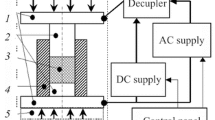Studies are made of the cutting of ultrahard materials (refractories, concretes, ceramics, single crystals) and relatively “soft” refractories and natural stones by using disks with two types of diamond-bearing layer: a layer with a cluster design (fine aggregates with a high-density diamond distribution) and a layer with a fragmentary design (coarse aggregates with a significantly less dense diamond distribution). Use of these types of diamond-bearing layer increases both cutting speed and tool life compared to the traditional uniform distribution of diamonds. The cluster design is effective for cutting ultrahard materials, while the fragmentary design is best suited for cutting softer materials.






Similar content being viewed by others
References
A. V. Belyakov and S. I. Tserman, “The synergistics of cutting brittle inorganic nonmetallic materials with a diamond tool,” Novye Ogneupory, No. 3, 106 – 118 (2014).
Abrasive Diamond Tool. Unified Consumption Norms, VNIITEMR, Moscow (1989).
J. Konstanty, “Cobalt as a matrix in diamond impregnating tool for stone sawing applications,” Wydawnictwa AGH, Krakow (2002).
A. V. Belyakov and S. I. Tserman, “Cutting of Bakor by a tool with diamonds arranged in clusters,” Novye Ogneupory, No 5, 34 – 37 (2011).
S. P. Pyun, H. W. Lee, and J. H. Park, “Study for cutting performance in arrayed diamond saw blade,” 1st International Industrial Diamond Conference. October 20 – 21, Barcelona.
A. V. Belyakov and S. I Tserman, “Cluster arrangement of diamonds in segments for machining natural and artificial brittle nonmetallic materials,” in: The Mining, Processing, and Use of Natural Stone. Symposium, MGTU im. G. I. Nosova, Magnitogorsk (2011). Vol. 11, pp. 247 – 252.
A. V. Belyakov and S. I. Tserman, “Formation of the structure of the diamond-bearing layer in a tool designed to cut natural stone,” in: The Mining, Processing, and Use of Natural Stone. Symposium, MGTU im. G. I. Nosova, Magnitogorsk (2014). Vol. 14, pp. 203 – 208.
G. D. Pershin, V. V. Serdyukov, and M. Yu. Gurov, “Study of the mechanical conditions for sawing natural stone with a disk-shaped diamond tool,” in: The Mining, Processing, and Use of Natural Stone. Symposium, MGTU, Magnitogorsk (2001), Vol. 1, pp. 119 – 129.
GOST 9206–80. Diamond Powders. Specifications, Izd-vo Standartov, Moscow.
Author information
Authors and Affiliations
Corresponding author
Additional information
Translated from Novye Ogneupory, No. 12. pp. 14 – 17, December, 2014.
Rights and permissions
About this article
Cite this article
Belyakov, A.V., Tserman, S.I. Formation of the Structure of a Diamond-Bearing Layer in a Tool by the Aggregation of Cutting Grains. Refract Ind Ceram 55, 501–504 (2015). https://doi.org/10.1007/s11148-015-9753-0
Received:
Published:
Issue Date:
DOI: https://doi.org/10.1007/s11148-015-9753-0




